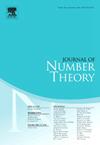Common values of linear recurrences related to Shank's simplest cubics
IF 0.6
3区 数学
Q3 MATHEMATICS
引用次数: 0
Abstract
Let not all zeroes and let be the linear recursive sequence, which is defined by the initial terms and whose characteristic polynomial is Daniel Shanks simplest cubic . We prove that there exists an effectively computable constant c depending only on such that if holds for some integers with then . For the choices we solve the above equations completely. At the end we give an outlook to the equation for some fixed integers .
与尚克最简单立方体有关的线性递归的常见值
设 A,B,C∈Z 不全为零,并设 F(u,n)=F(A,B,C,u,n) 为线性递推序列,该序列由初始项 F(u,0)=A,F(u,1)=B,F(u,2)=C 定义,其特征多项式为丹尼尔-香克斯最简立方 Su(X)=X3-(u-1)X2-(u+2)X-1,u∈Z。我们证明存在一个有效的可计算常数 c,它只取决于 L=max{|A|,|B|,|C|},这样,如果|F(A,B,C,u,n)|=|F(A,B,C,u,m)|对某些整数 u,n,m 成立,且 n≠m,那么|n|,|m|<c。对于(A,B,C)∈{(0,0,1),(1,-1,1)}的选择,我们可以完全解出上述方程。最后,我们给出了对一些固定整数 n,m 的方程 F(0,0,1,u,n)=F(0,0,1,v,m) 的展望。
本文章由计算机程序翻译,如有差异,请以英文原文为准。
求助全文
约1分钟内获得全文
求助全文
来源期刊

Journal of Number Theory
数学-数学
CiteScore
1.30
自引率
14.30%
发文量
122
审稿时长
16 weeks
期刊介绍:
The Journal of Number Theory (JNT) features selected research articles that represent the broad spectrum of interest in contemporary number theory and allied areas. A valuable resource for mathematicians, the journal provides an international forum for the publication of original research in this field.
The Journal of Number Theory is encouraging submissions of quality, long articles where most or all of the technical details are included. The journal now considers and welcomes also papers in Computational Number Theory.
Starting in May 2019, JNT will have a new format with 3 sections:
JNT Prime targets (possibly very long with complete proofs) high impact papers. Articles published in this section will be granted 1 year promotional open access.
JNT General Section is for shorter papers. We particularly encourage submission from junior researchers. Every attempt will be made to expedite the review process for such submissions.
Computational JNT . This section aims to provide a forum to disseminate contributions which make significant use of computer calculations to derive novel number theoretic results. There will be an online repository where supplementary codes and data can be stored.
 求助内容:
求助内容: 应助结果提醒方式:
应助结果提醒方式:


